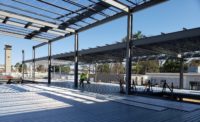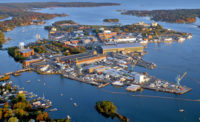On scenic Peirce Island, where the earthen remains of Fort Washington hearken back to the Revolutionary War and the War of 1812, building the largest public works project in Portsmouth, N.H., history required close coordination from Day 1.
Crews tasked with upgrading the Portsmouth Wastewater Treatment Plant on the banks of the Piscataqua River in the same footprint as the existing plant had to maintain wastewater treatment operations and public pool access. The project team, led by Plaistow, N.H.-based Methuen Construction, also had to manage traffic flow and deliveries on a single access road to the rocky 27-acre historic island.
“The city and us had to set up schedules on when things could happen,” says Andy Brodeur, Methuen project superintendent. “We have to write in every subcontract and every purchase order that the delivery has to be here at a certain time, and if it’s over a certain length, they have to be escorted in and out by the police.”
The four-year, $73-million, design-build, lump-sum project—part of the city’s overall $99.9-million package for the facility—is on budget and on schedule to meet its federal consent decree deadlines. The upgraded plant includes a biological-aerated filter (BAF) system to treat an average of 6.1 million gallons per day, replacing a 1990 sand-filtration system that treated an average of 4.8 mgd.
The system can treat nitrogen at 8 milligrams per liter (mg/l) in the effluent and achieve a limited 3 mg/l treatment with operational adjustments.
“This project will result in a significant change in the treatment level at the facility,” says John Bohenko, Portsmouth city manager. “Environmental Protection Agency regulatory requirements drove the level of treatment needs beyond just secondary treatment to also include nitrogen removal,” he says.
The project involves work on six structures, including construction of a single-story, 2,700 sq-ft headworks building, completed last May; a three-story, 12,232-sq-ft sludge-processing building; a four-story, 11,407-sq-ft BAF building; a 40-ft-dia by 20-ft-tall gravity-thickener facility; and an electrical building. Crews are retrofitting the solids building to convert it into a two-story, 6,750-sq-ft administration building. The project also includes replacing grit-removal equipment and primary and thickened-sludge pumping systems.
Maintaining wastewater treatment operations and public pool access during construction involved “installing temporary systems, relocating plant operations and utilizing new infrastructure on an interim basis to free areas for demolition and reconstruction,” says Greg Galbraith, Methuen project executive.
Keeping crews working effectively on the tight 3.8-acre project site has required planning and careful coordination. The team repurposed a public pool parking lot into a construction trailer complex and reconstructed the new pool parking lot with a permeable pavement cross section for stormwater control. It also had the city relocate a snow dump off the island so it could use the space as part of the staging area.
“There’s a beehive of activity between different buildings under construction, making it tough to keep everyone in different trades marching in the same direction,” says Erik Meserve, AECOM project engineer, who worked on 3D design of wastewater systems using AutoCAD.
Driven By Decree
A 2009 federal consent decree mandated that the city construct a secondary wastewater treatment facility by a March 2017 deadline. The decree settled a lawsuit alleging the city discharged contaminated wastewater into the Great Bay Estuary, fed by the tidal waters of the Piscataqua River. However, in 2012, the original schedule was extended to allow electrical service to continue in an old facility building “long enough to build the new electrical service,” says Terry Desmarais, engineer for the city of Portsmouth. Under the modified consent decree, construction of the BAF system must be permitted by April 2020.
“There’s a beehive of activity between different buildings ...”
– Erik Meserve, Project Engineer, AECOM
Before choosing a high-rate, small-footprint type wastewater treatment system, the city took the unusual step of investing $1.8 million to build three small-scale, side-by-side pilots of treatment systems in 2011 and 2012 at the site of the new headworks building. The largest of those was 26 ft long by 4 ft wide by 8 ft deep. “At the conclusion, we were able to find a treatment technology that fit the physical constraints and provided flexibility for meeting what we thought were potential future nitrogen-removal requirements,” Desmarais says.
The 250-ft-long by 100-ft-wide by 40-ft-high BAF system “was selected over the other two technologies due to factors such as the ability of the BAF to achieve an increased level of nitrogen removal with no additional capital cost, only requiring an increase in the amount of supplemental carbon added to the second-stage BAF,” Pearson says. Bohenko adds that “any other selection would likely have had long-term permanent impacts on the recreational trails and other facilities on Peirce Island.”
Unlike a conventional waste-activated-sludge system, this high-rate, small-footprint facility can handle treating and settling in the same basin, Desmarais says. As a combined collections system, it has a secondary treatment bypass for wet-weather treatment. “We are the only combined sewer-treatment plant in the estuary,” he adds.
If the system goes beyond the maximum flow of 9.1 mgd in wet weather, the remaining flow, up to 22 mgd, will be diverted around the BAF into a secondary bypass, thereby receiving only enhanced primary treatment.
Line Stop Installation
One of the project’s biggest challenges involved managing traffic flow and site deliveries on the one available access road. An aging bridge connects the island to the narrow roads in Portsmouth’s historic South End. After structurally evaluating the 300-ft-long by 35-ft-wide two-lane bridge, the city, in a separate contract, hired George Cairns & Sons to complete a $400,000 deck replacement before work on the water treatment plant began in September 2016.
“The earthen remains of the fort have been fenced off for historic preservation on both sides of the site, adding limits to the already constrained site.”
– Jon Pearson, Executive Vice President, AECOM
The team had to install a bypass system before construction of the headworks could begin, says Kyle Tenan, Methuen superintendent. It took crews hours of jack-hammering with handheld pneumatic hammers and a 12,000-lb hoe ram to expose the pipe.
South Shore Pipeline installed and tested a tapping saddle and line stop during day shifts in mid-May 2017, reserving pipe-cutting for night when flows are lowest. After closing a preinstalled valve, crews fused and installed nearly 400 ft of 24-in., high-density polyethylene (HDPE) bypass pipe before installing the line stop, which diverts flow through the bypass. It was “the most intricate portion of the process,” Tenan says.
On June 6, crews began work to “drop the head,” closing the valve, which stopped the influent flow through the existing line, forcing wastewater into the temporary bypass piping. Shortly after 2 a.m., the crew witnessed the flow discharging from the bypass pipe into the grit chambers. The complex procedure took place “flawlessly,” Tenan recalls.
Construction of the headworks overlapped with relocation of all the facility’s computer-controlled instrumentation so the team could construct the BAF building. “The power feed and electrical gear for the existing plant sat directly in front of the proposed BAF facility,” Galbraith says. This prevented work from starting until the new permanent power source was established and the electrical building was constructed.
To expedite the schedule, Methuen—working with the city, Eversource and Wayne J. Griffin Electric—established a rerouted power feed and temporary backup generator so demolition of the old infrastructure and construction of the new BAF facility could begin earlier.
“When one building with a lot of computer-based controls was under demolition, the team found a way to consolidate computer-based controls in the headworks to expedite construction of the electrical changes up front,” Desmarais recalls.
Documenting History
During permitting, archaeologists worked on site to assess the historic significance of the area, Desmarais says. Fort Washington was established on the island’s high point in 1775 and saw action when a British ship sailed into the harbor, mistaking it for Boston Harbor.
“There were ruins, but they’re gone now,” says Jon Pearson, AECOM executive vice president. “The earthen remains of the fort have been fenced off for historic preservation on both sides of the site, adding limits to the already constrained site.”
An unanticipated development occurred in 2015, when the sludge-processing building turned 50 years old, and the following year, it was designated a contributing building to the then-proposed National Register for Portsmouth’s downtown historic district.
“As part of our work and permitting, we had to complete a history of the treatment plant, including documenting the sludge-processing building,” Desmarais recalls. The city also was required to provide interpretive signage about the Peirce Island Wastewater Treatment Facility’s historic significance.
Soon, half of the sludge building will be removed, with the remaining half used for new sludge-processing operations, scheduled to go online by December. The top half will be razed and replaced with a new lab administration building, Desmarais says. The old lab administration building, currently housing sludge operations scheduled for decommissioning in June, will be demolished once the new sludge system is operational.
Desmarais is pleased the project is nearing completion, but “in the last 25% push,” he wants to avoid fatigue from construction so the team finishes strong. Most importantly, he wants to be confident his team is ready to take control of the plant. While Methuen is “getting ready to pack up and move on, they can expend all their energy, but our staff has to start ramping up to run the plant.”












Post a comment to this article
Report Abusive Comment